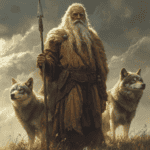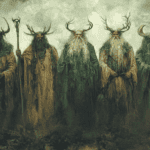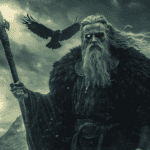
The Norse pantheon, a rich tapestry of deities, heroes, and mythical beings, has captivated imaginations for centuries. This complex mythology, rooted in the beliefs of the ancient Scandinavian peoples, offers a fascinating glimpse into the worldview of the Vikings and their ancestors.
The Structure of the Norse Pantheon
The Norse pantheon is primarily divided into two main groups of gods: the Æsir and the Vanir. These two divine families once engaged in a legendary war before eventually merging into a unified pantheon.
The Æsir, generally associated with war, power, and kingship, form the principal group of gods in Norse mythology. They reside in Asgard, one of the Nine Worlds connected by the cosmic tree Yggdrasil. The Vanir, on the other hand, are closely linked with nature, fertility, and wisdom. Initially separate from the Æsir, they eventually joined forces after the Æsir-Vanir War.
Key Figures in the Norse Pantheon
Odin: The All-Father
At the head of the Norse pantheon stands Odin, the All-Father. As the god of wisdom, poetry, death, and magic, Odin’s influence permeates Norse mythology. His insatiable thirst for knowledge led him to sacrifice one of his eyes at Mímir’s well in exchange for wisdom. Odin is often depicted as a one-eyed, bearded man wielding his magical spear Gungnir.
Odin’s role extends beyond mere kingship. He is the patron of rulers, warriors, and poets alike. His hall, Valhalla, serves as the final resting place for half of all warriors who die in battle, with the other half going to the goddess Freyja’s hall, Fólkvangr.
Thor: The Thunderer
Perhaps the most recognizable Norse god in popular culture, Thor is the god of thunder, lightning, storms, and strength. Son of Odin and the earth goddess Jörð, Thor is renowned for his mighty hammer Mjölnir, which he uses to protect both gods and humans from the forces of chaos and destruction.

Thor’s popularity among the Norse people stemmed from his role as a protector of humanity. He was often invoked for protection during sea voyages and was associated with fertility and agriculture, making him a vital figure in Norse society.
Frigg: The All-Mother
Frigg, Odin’s wife and the queen of Asgard, embodies wisdom, foresight, and maternal love. As the goddess of the sky and heavens, she oversees the well-being of families and the protection of home and hearth. Frigg possesses the knowledge of all things past, present, and future, though she seldom shares this information.
The story of Frigg’s attempt to protect her son Baldr from all harm, only to be thwarted by Loki’s cunning, is one of the most poignant tales in Norse mythology.

Freyr and Freyja: The Divine Twins
Freyr and Freyja, twin deities of the Vanir, represent different aspects of fertility and abundance. Freyr, associated with male fertility, sunlight, and fair weather, was particularly revered in Sweden. His sister Freyja, the goddess of love, beauty, and fertility, was equally important and popular.
Freyja’s domain extends beyond love and beauty. She is also associated with war, death, and magic, sharing the fallen warriors with Odin. Her chariot, pulled by cats, and her magical necklace Brísingamen are iconic symbols in Norse mythology.
Loki: The Trickster God
Loki, often considered the most complex figure in Norse mythology, is the god of mischief, trickery, and chaos. His actions frequently cause problems for the other gods but also lead to solutions. Loki’s role in Norse mythology is ambiguous, oscillating between helpful ally and dangerous enemy of the gods.
Loki’s children, including the wolf Fenrir, the world serpent Jörmungandr, and Hel, the ruler of the underworld, play crucial roles in Norse eschatology.
Lesser-Known Deities
While gods like Odin, Thor, and Loki often take center stage, the Norse pantheon includes numerous other deities, each with their own unique attributes and stories.
Baldr: The Bright God
Baldr, son of Odin and Frigg, is the god of light, joy, purity, and the summer sun. His death, orchestrated by Loki, is a pivotal event in Norse mythology, marking the beginning of the chain of events that will ultimately lead to Ragnarök.
Tyr: God of Law and Honor
Tyr, once considered the head of the Norse pantheon before being supplanted by Odin, is the god of law, justice, and heroic glory. His sacrifice of his hand to bind the wolf Fenrir exemplifies his unwavering commitment to duty and honor.
Heimdallr: The Watchman
Heimdallr, the ever-vigilant guardian of Asgard, stands watch at the Bifröst bridge. Known for his keen senses, including the ability to hear grass growing, Heimdallr will sound his horn Gjallarhorn to signal the onset of Ragnarök.
Njörðr: God of the Sea and Wealth
Njörðr, a Vanir god adopted into the Æsir, rules over the sea, wind, fish, and wealth. As a deity associated with maritime activities and prosperity, Njörðr was often invoked by sailors and traders seeking safe voyages and abundant riches.
The Role of Goddesses
While male gods often dominate discussions of Norse mythology, goddesses played crucial roles in the pantheon and were deeply revered.
Sif: Goddess of the Harvest
Sif, Thor’s wife, is associated with fertility and the harvest. Her golden hair, crafted by dwarves after Loki cut off her original locks, symbolizes fields of golden wheat.
Idun: Keeper of Youth
Idun guards the magical apples that keep the gods young and immortal. Her abduction by the giant Þjazi and subsequent rescue is a key myth highlighting the gods’ vulnerability.
Hel: Ruler of the Underworld
Hel, daughter of Loki, rules over Helheim, the realm of those who die of old age or disease. Often depicted as half-living and half-dead, Hel plays a significant role in the myth of Baldr’s death.
Mythical Creatures and Other Beings
The Norse cosmos is populated not only by gods but also by a variety of other mythical beings that play crucial roles in the mythology.
The Norns
The Norns, similar to the Greek Fates, are three female beings who shape the destinies of gods and humans alike. They tend the world tree Yggdrasil and determine the course of all lives.

Valkyries
The Valkyries, female warrior spirits, serve Odin by choosing who will die in battle and bringing their souls to Valhalla. They are often depicted as fierce maidens riding flying horses across the sky.
Giants (Jötnar)
The giants, or Jötnar, are the primordial beings of Norse mythology. Often at odds with the gods, they represent the chaotic forces of nature. Some giants, like Loki, became integrated into the pantheon through marriage or adoption.
Cosmology and the Nine Worlds
Norse mythology presents a complex cosmology centered around Yggdrasil, the world tree that connects the Nine Worlds. These worlds include:
- Asgard: Home of the Æsir gods
- Vanaheim: Realm of the Vanir gods
- Alfheim: World of the light elves
- Midgard: The human world
- Jotunheim: Land of the giants
- Nidavellir/Svartalfheim: Realm of the dwarves
- Niflheim: World of ice and mist
- Muspelheim: Realm of fire
- Helheim: The underworld ruled by Hel
This intricate cosmology reflects the Norse understanding of the universe and their place within it.
The Cycle of Creation and Destruction
Norse mythology is characterized by its cyclical view of time, encompassing both creation and destruction.
The Norse creation myth begins with the primordial void called Ginnungagap. From the interaction of ice from Niflheim and fire from Muspelheim, the first beings emerged, including the primordial giant Ymir and the cosmic cow Audhumla. Odin and his brothers slew Ymir and used his body to create the world.
Ragnarök, the prophesied end of the world, looms large in Norse mythology. This apocalyptic event will see the deaths of many gods, including Odin, Thor, and Loki, as well as the destruction and subsequent rebirth of the world.
The concept of Ragnarök reflects the Norse belief in the cyclical nature of existence, where destruction paves the way for renewal.
Conclusion
The Norse pantheon, with its array of gods, goddesses, and mythical beings, offers a fascinating window into the beliefs and values of the ancient Norse people. From the wisdom-seeking Odin to the thunder-wielding Thor, from the complex Loki to the nurturing Frigg, these deities embody various aspects of the natural world and human experience.
In the end, the Norse pantheon is more than just a collection of deities – it’s a mirror reflecting the hopes, fears, and aspirations of those who created these myths. As we delve into these stories, we can learn about their ancient beliefs.





